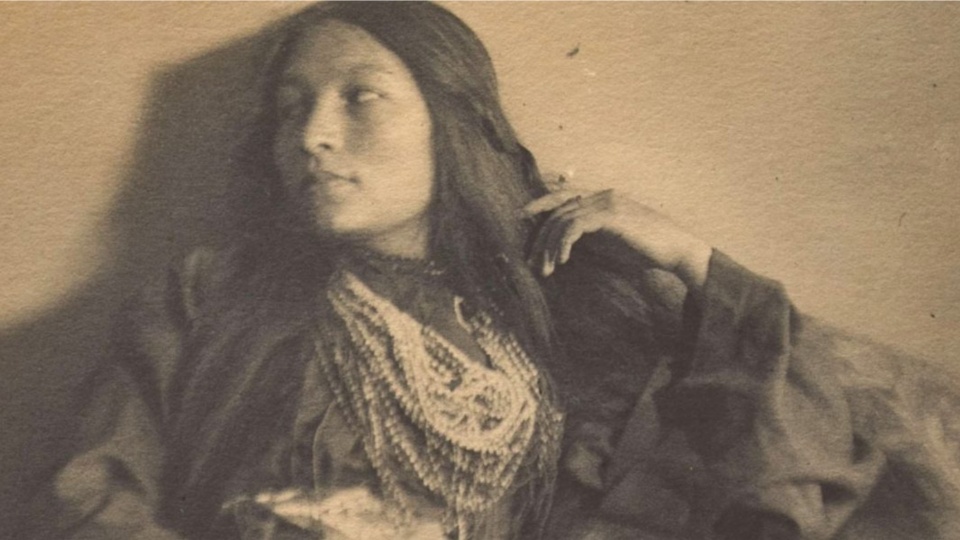
In 1923, a Dakota-born writer-activist traveled through Oklahoma as a research agent of the Indian Rights Association to investigate abuses against the Choctaw, Creek, and other tribes. What she found and documented was an appalling rampage of fraud, larceny, racial intimidation, and murder.
Bearing witness to the atrocities, Zitkála-Šá lent her name and her fury to a 39-page report under the title Oklahoma’s Poor Rich Indians: An Orgy of Graft and Exploitation of the Five Civilized Tribes—Legalized Robbery. This brave exposé, calling for “radical and immediate change,” deserves to be memorialized as a crucial step forward in the Native American struggle.
The situation was historically rooted in the Dawes Act or Land Allotment Act of 1887. Under the stated goal of “civilizing” Indigenous peoples, the Dawes Act reneged on existing treaties by abolishing communal land ownership and superimposing on tribal society a capitalist framework of private property.
Millions of acres of reservation land were broken up into individual allotments, ostensibly for the purpose of encouraging Native Americans to adopt the cultural practices of white farmer-settlers.

The promised benefits of coercive assimilation never materialized; instead, the law became a tool for rapacious Anglo-Americans to steal Indian land.
Among the provisions of the Dawes Act was the appointment of white “guardians” for Native American landowners. By 1923 there were 4000 professional guardians in Oklahoma, entrusted with Indian properties ranging in value from a few thousand dollars up into the millions.
Such oversight of Native peoples by Anglo-American agents of the capitalist order clearly smacked of paternalism, but that wasn’t the worst of it. While protecting almost no one, the guardians colluded with judges, land lawyers, and local governments in a criminal program of pauperization and virtual extermination.
Zitkála-Šá’s report, compiled in November-December 1923 and co-authored with two representatives of cooperating Indian defense agencies, described “a situation that is almost unbelievable in a civilized country”:
- Over 90% of Native Americans had either been divested of their land for inadequate compensation or “shamelessly and openly robbed in a scientific and ruthless manner.”
- Anglo-American authorities—including judges, attorneys, guardians, bankers, and merchants—had displayed “a flagrant disregard of the Indians’ welfare highly lucrative to those empowered to protect Indian interests.”
- In dozens of local governments and courts, the principal enterprise and source of revenue was the corrupt handling of Indian estates.
- An examination of over 14,000 probate cases revealed that administrative charges levied against Indian owners were sometimes as high as 70% and were accompanied by “unconscionable” fees and commissions.
- The discovery of oil on Native land was often considered prima facie evidence of the owner’s “incompetence.” In the appointment of a white guardian for such property the landholder’s wishes were rarely considered.
- Indian children were dying of malnutrition due to the indifference of guardians who refused to dispense funds from Indian bank accounts to care for them.
- Native American women had been kidnapped, raped, and robbed of their property by white blackmailers and grafters.
- Sick and elderly Indian landholders on their deathbeds were swarmed by grafters using coercion to obtain thumbprint signatures on fraudulent wills.
- “Dead or alive, the grafters manage to ‘get’ the Indian,” the report concluded.
a.k.a. Gertrude Simmons Bonnin
Zitkála-Šá, known also under the name Gertrude Simmons Bonnin, was born in 1876 on the Yankton Sioux reservation in South Dakota. At the age of eight, she was taken from the reservation by missionaries and placed in a Quaker boarding school in Indiana. The rest of her childhood was painfully bicultural. Going back and forth between schools and the reservation, she experienced difficult readjustments in each setting.
In 1895 she enrolled in Earlham College, excelled in her studies, and began publishing poems. The next year she participated in the Indiana State Oratorical Contest, where she won second place in the public debate category despite being subjected to barbaric race and gender-based harassment during the competition. After graduation she was hired to teach at the Carlisle Indian Industrial School, founded and run by retired army general Richard Henry Pratt, who coined an infamous rallying cry for cultural genocide: “Kill the Indian, to save the man!”
In 1899 Zitkála-Šá left Carlisle to study music at the New England Conservatory in Boston, where she also wrote short stories that won immediate recognition. From 1900 to 1902, she placed a handful of semi-autobiographical stories in prestigious journals including Harper’s and the Atlantic Monthly. A literary sensation, her work appeared alongside the likes of Stephen Crane, Edith Wharton, and W.E.B. Du Bois.
In 1913, her literary and musical talents were put to political use. After the U.S. Department of Interior banned the Sun Dance, a Native American religious ritual, she collaborated with the Mormon music professor William Hanson to evade censorship and celebrate Indigenous spirituality in the form of a libretto, The Sun Dance, performed in Utah to critical acclaim.
These experiences assured that by the time she researched the plight of the “Poor Rich Indians” of Oklahoma in 1923, Zitkála-Šá was already a “red progressive” whose expressions of outrage took multiple forms.
“Blue-Star Woman”
Two years prior to her investigations in Oklahoma, she had published a short story that denounced the Dawes Act, not by citing cases and statistics, but by exploring the heartbreaking cultural tragedy from a personal perspective.
“The Widespread Enigma Concerning Blue-Star Woman” appeared in 1921 in the book-length collection, American Indian Stories. The tale is set on the western plains of the Yankton Reservation, but it applies to any area affected by Dawes-era allotment policies. Its protagonist is a solitary Sioux woman, destitute and orphaned as a child, who has reached the age of 53 owning nothing but a log hut. Facing starvation, she is informed that “In the eyes of the white man’s law,” she can acquire land if she will give proof of her identity and “membership in the Sioux tribe.”
Her heart tells her that a piece of the earth is her birthright rather than a privilege. Moreover, she realizes that the formalities of property acquisition carry spiritual costs: Blue-Star recalls the Sioux teachings that “an Indian should never pronounce his or her name in answer to any inquiry” and that the names of her parents, “long gone to the spirit-land,” were especially subject to this taboo.
Two young assimilated Indians approach her with a solicitation. These “would-be white men,” wearing celluloid collars “like shining marks of civilization,” are seen by Blue-Star as “deluded mortals” who feign concern for her. Like their white role models (Dawes Act guardians), they promise to secure her allotment in exchange for half of her land and money when she gets them. Because “a little something to eat is better than nothing,” Blue-Star agrees, but she perceives as well that her entire people are “a slowly starving race going mad.”
The Sioux elders learn that Blue-Star Woman has been enrolled as a tribe member and approved for an allotment. Outraged, they implore their chief to write to Washington in protest that “their property was given to a strange woman.” The chief enlists his educated granddaughter as his “interpreter and scribe” to produce the letter of appeal.
The letter is never sent. The chief makes a ten-mile journey on horseback to a field within sight of the reservation post office, only to have a sudden change of heart. Like Blue-Star, he comprehends the cultural poison of the entire allotment system. Before he reaches the cluster of government buildings near the reservation border, he kindles a small fire and, “crying aloud, for his sorrow was greater than he could bear,” tosses the letter into the flames, dissociating himself from the capitalist state.
Before the chief reaches home, white men on horseback advance upon him. They are “Indian police” wearing coats shining with brass buttons, and they arrest the “bad Indian” for “trying to set fire to the government agency.”
In a dingy prison cell, the elderly chief, a “voiceless man of America,” struggles to retain “hope for the day of salvation” and faith in humanity. His reward comes in a vision, the image of a huge woman standing “upon the brink of the Great Waters, facing eastward.” The Statue of Liberty, her face aglow with compassion, comes alive. Formerly, “she had turned her back on the American aborigine,” but now, turning majestically, she looks west:
“Her eyes swept across the outspread continent of America, the home of the red man. At this moment her torch flamed brighter and whiter till its radiance reached into the obscure and remote places of the land. Her light of liberty penetrated the Indian reservations. A loud shout of joy rose up from the Indians of the earth, everywhere.”
All too soon, the picture disappears and the chief awakens. When he is finally released from prison, he is greeted happily by the same swindlers who took Blue-Star Woman’s property. Using their influence with white authorities, they have secured the chief’s freedom for the identical price—half of his land.
“The old chieftain sighed but made no comment. Words were vain. He pressed his indelible thumb mark, his signature it was, upon the deed.”
Opera of the Year
A versatile writer, Zitkála-Šá strived to both factually document and fictionally represent the Indigenous cultural ethos while sending serious and savvy political messages. Her short story about the “enigma” of Blue-Star Woman, and her muckraking investigative journalism, are different ways of stating the same conclusion: “There is no hope of any reformation of the present system, and if action is delayed for a few years there will be no Indians with property to be protected. Legislation should be enacted at once.”

Zitkála-Šá’s work led to the formation of the Meriam Commission, whose 1928 findings addressed a range of injustices and pointed the way toward fundamental policy changes that expanded tribal civil rights.
Franklin Delano Roosevelt acknowledged Zitkála-Šá among those deserving credit for the Indian Reorganization Act of 1934, which ended Dawes Act abuses, recognized tribal governments, and repealed the longstanding ban on the Sun Dance.
One hundred years after her Oklahoma exposé, there are reasons to remember her. Here’s one of them: In 1938, the year of her death, her Sun Dance opera was revived on Broadway and recognized as “Opera of the Year.” William Hanson, its white co-author, was commended. Not recognized, however, was the opera’s female Native American co-creator. In the event program and in the New York Times review of The Sun Dance, there appeared neither her Anglicized name Gertrude Simmons Bonnin, nor Zitkála-Šá, nor even her translated Dakota name, “Red Bird.”
We hope you appreciated this article. At People’s World, we believe news and information should be free and accessible to all, but we need your help. Our journalism is free of corporate influence and paywalls because we are totally reader-supported. Only you, our readers and supporters, make this possible. If you enjoy reading People’s World and the stories we bring you, please support our work by donating or becoming a monthly sustainer today. Thank you!












Comments